Rare and beautiful stones have long been transformed into precious jewelry across a wide variety of nations and cultures, regardless of their differences in lifestyles. The rarity of these natural gems always determines their price and value in society, and there is little in nature that compares to the allure of a sparkling, bright crystal—except perhaps flowers, which are, well, too short-lived, unlike the enduring appeal of gemstones.
The history of gemstones is as old as the history of civilization, and in the Paleolithic Age, tens of thousands of years ago, people had already learned to make beads and pendants from stones soft enough to be worked with stone tools and beautiful enough to make primitive collectors want to use them to decorate themselves. Green feldspar, yellowish-brown pyrophyllite, and the transparent mineral antigorite are amongst the popular favorites of Paleolithic jewelry.
Today, these stones are no longer considered worthy of a jeweler’s attention because over the past few millennia, people have become much more knowledgeable about truly rare stones, not to mention the advances made in how to work them. Today, it is possible to take a dull, shapeless lump that our ancestors would not even look at and turn it into a shining miracle.
It should be remembered that the history of diamonds began only in the thirteenth to fourteenth centuries, when people finally learned how to properly cut this king of gems. Before that, the diamond was considered a rare but not very valuable stone.
Many other gemstones have also had a complicated history, shaped by their cultural significance and the way they’ve been mined, traded, and valued over centuries. To delve into this topic, expert gemologist and director of Educational Program Development at the Gemological Center of Moscow State University Elena Novoselova, who came to Astana at the end of September 2024 for a lecture organized by the House of Bvlgari, kindly agreed to answer our questions.
The House of Bvlgari is famous for its love of rare, luminous gemstones. For a century and a half, ever since it was founded, its master craftsmen and designers have experimented with combining stones of very different colors in a single product, creating compositions of incredible elegance and originality. This is why Bvlgari has a longstanding tradition of searching for the best stones, the most unusual finds in the mines, and when the depths of the Earth give birth to a new sparkling miracle, there is no doubt that Bvlgari’s specialists will be among those waiting to welcome it.
Spinel
Until the sixteenth and seventeenth centuries, virtually any transparent, bright red stone was considered a ruby. The term ‘ruby’ comes from the Latin word ruber, meaning ‘red’; the stones were also called carbuncles, garnets, anthraxes, and so on. It was only with the development of chemistry and mineralogy that scientists began to realize that these beautiful red gems had different compositions and structures and should therefore be classified as different stones. Thus, many precious rubies in royal treasuries became garnets, tourmalines, and beryls.
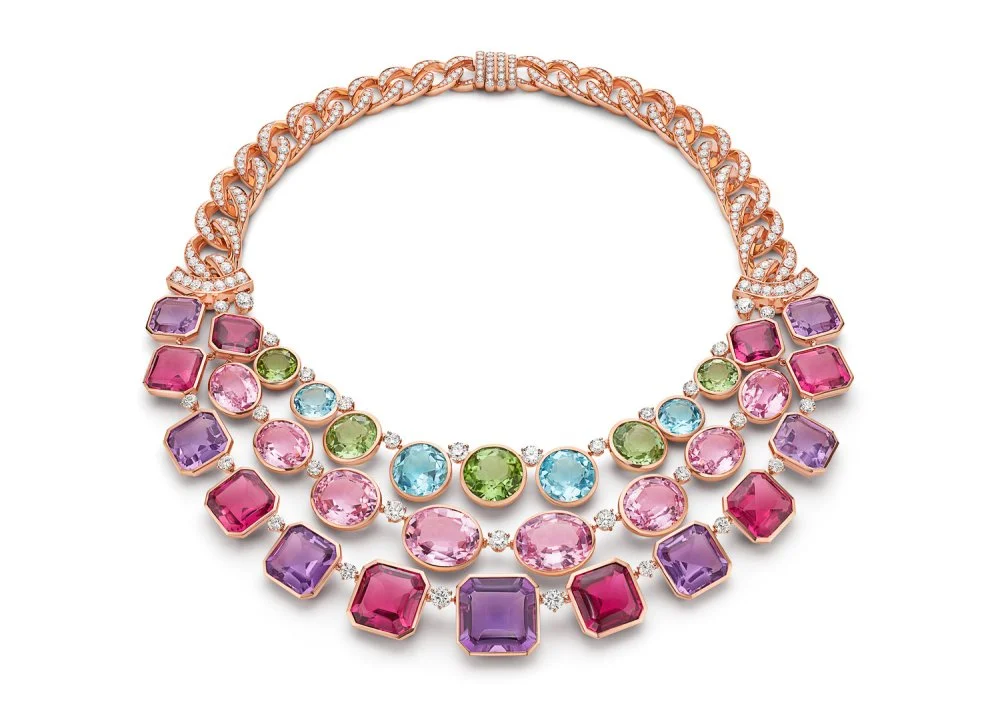
Necklace with spinel of different colors. Bvlgari
But more often than not, the most beautiful sparkling stones turned out to be spinel. The stone got its name from the Latin word spinella, meaning ‘little thorn’, due to the sharp ends of its crystals. But it could be distinguished from a ruby in its cut form only after powerful microscopes were invented. The difference in the structure of these stones is impossible to distinguish with the naked eye. The Black Prince’s Ruby, arguably the most famous ruby in the history of Europe, which adorns the imperial crown of Great Britain, turned out to be spinel. The famous Timur Ruby, which belonged to the Timurid dynasty for a long time, is also a spinel.
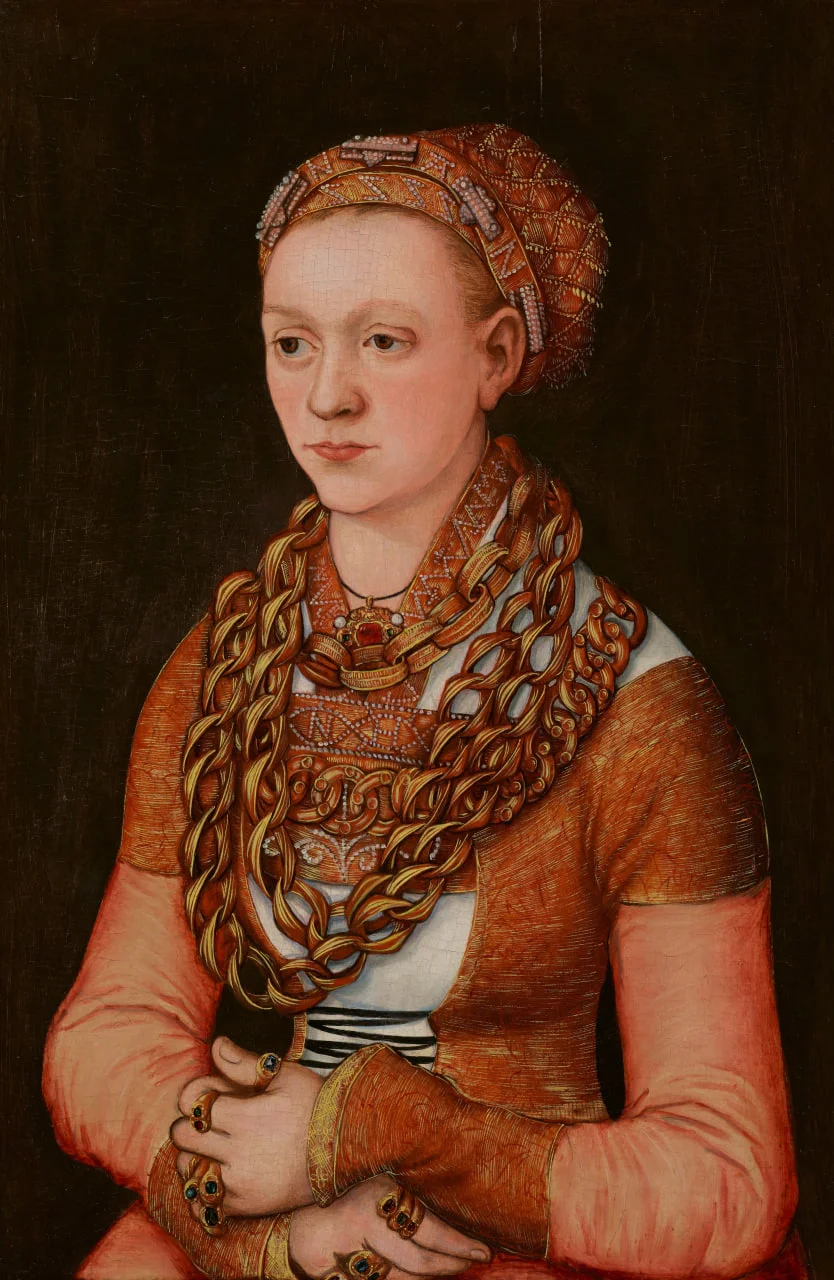
Portrait of Anna Buchner, née Lindacker, c. 1520, Lucas Cranach the Elder, German, (Saxony)/Getty Images
Today, spinel is one of the most popular stones among jewelers, ranking among the first-order gemstones along with sapphires, diamonds, and rubies. Noble spinels can have different colors, from orange to blue, but the most popular is still the red spinel of a rich crimson, scarlet, pink or purple wine color. And although spinel often costs less than rubies of the same size, except for the finest specimens, it has greater decorative value because of its rich palette of colors. In Bvlgari collections, for example, spinel often takes the lead among other gemstones. One of Bvlgari’s treasures is the Imperial Spinel Necklace, which has the fourth-largest known spinel in the world. Found in Tajikistan, the 131.21-carat deep red stone, the centerpiece of the necklace, is surrounded by an array of diamonds and emeralds.
Questions for a gemologist: Why does Bvlgari value spinel so much?
‘As is the case with any colored gemstone, we value color above all else. Spinel is an amazing mineral with a wide range of natural colors. The colors of spinel cover almost the entire spectrum of the rainbow—red, orange, green, blue, purple, gray, pink—you can find spinels of all shades!
‘Spinel measures eight on the Mohs scale of mineral hardness,i

Every Nizam had a special crown made for him for ceremonial purposes and they mostly used to be made of emeralds and diamonds and pearls all set in gold. This one has Burmese rubies as the main decorative motif/Wikimedia Commons
Emerald
Emerald is a variety of beryl, the most precious of all. Until 1790, however, the emerald was considered a separate type of stone, unrelated to the rather cheap beryl. Even after the French chemist Louis N. Vauquelin proved that the two stones had the same chemical composition, jewelers, not to mention the general public, categorically refused to acknowledge this fact for another 100 years. For thousands of years, emerald was considered the most precious of all stones, transparent and glowing with green light, created by nature itself in pristine perfection: a little polishing, not even cutting, is enough to make it glow with a deep green fire. The emerald was long shrouded in mysticism, mystery and legend. Babylonian kings used it to command the spirits, and biblical priests carried it in their staffs as a sign of their connection with the heavens.

Terra Mater Serpenti necklace with the large emerald. Bvlgari
And here are some beryls that claim to be related—every shopkeeper has presentation cufflinks made of beryl!
However, this shocking discovery did not affect the price of emeralds. To this day, a good, flawless emerald is worth more than a diamond of the same size.
Questions for a gemologist: Which emeralds are more valuable, the dark or light ones? What should one keep in mind when buying emeralds?
‘Let’s get the terminology straight. In gemology, there is a concept known as saturation, which is the concentration of color in the stone. In an emerald, this would be the amount of green the stone has. So the higher the saturation, the more expensive the stone. This is a basic rule of gemology, and it applies fully to emeralds.
‘Separately, we must also consider the concept of “tone”, which is the conventional placement of a stone on a scale from light to dark, the amount of light or darkness in a stone, and this amount can vary.

James VI and I, 1566 - 1625. King of Scotland 1567 - 1625. King of England and Ireland 1603 - 1625, by John de Critz, 1604. Oil on canvas/National Galleries Of Scotland/Getty Images
‘The most expensive emeralds are those that are as rich in color as possible but with optimal tone, or be moderately dark/light—it is the combination of these characteristics that is important. Emeralds from the Muzo deposit in Colombia are undoubtedly the benchmark for emerald color in the world market.
‘In recent years, however, we have seen a growing interest in the market for emeralds of low saturation, of a light green shade. Such stones have been given the trade name “mint emerald”. In the classic “emerald” cut, these stones look very dignified and are more affordable.
‘While buying an emerald, it is important to remember that emeralds are very rarely pure, that is, without inclusions. Emeralds are genetically characterized by the presence of mineral inclusions, entire systems of gas-liquid inclusions, and internal cracks. In the market, the inner world of emeralds is romantically called “jardin”, meaning “a garden”, and true connoisseurs of this magnificent gemstone find a unique charm in the microcosm of these inclusions.’
Paraiba
Tourmalines are always very lustrous, often transparent stones. In ancient times, they were mostly mined in India, and they were mostly red tourmalines, which no one knew how to distinguish from rubies. Both were called using the same word—lal, meaning ‘red’. Scientific discoveries down the years helped jewelers separate tourmalines into a different type of stone. It turned out that there were many rather inconspicuous, dull-colored pebbles among the tourmalines—for example, yellowish-beige manganese or black-brown ferruginous tourmalines. And so, the tourmaline fell into the category of semiprecious stones, although some bright, large specimens of it—usually red—were quite highly valued.
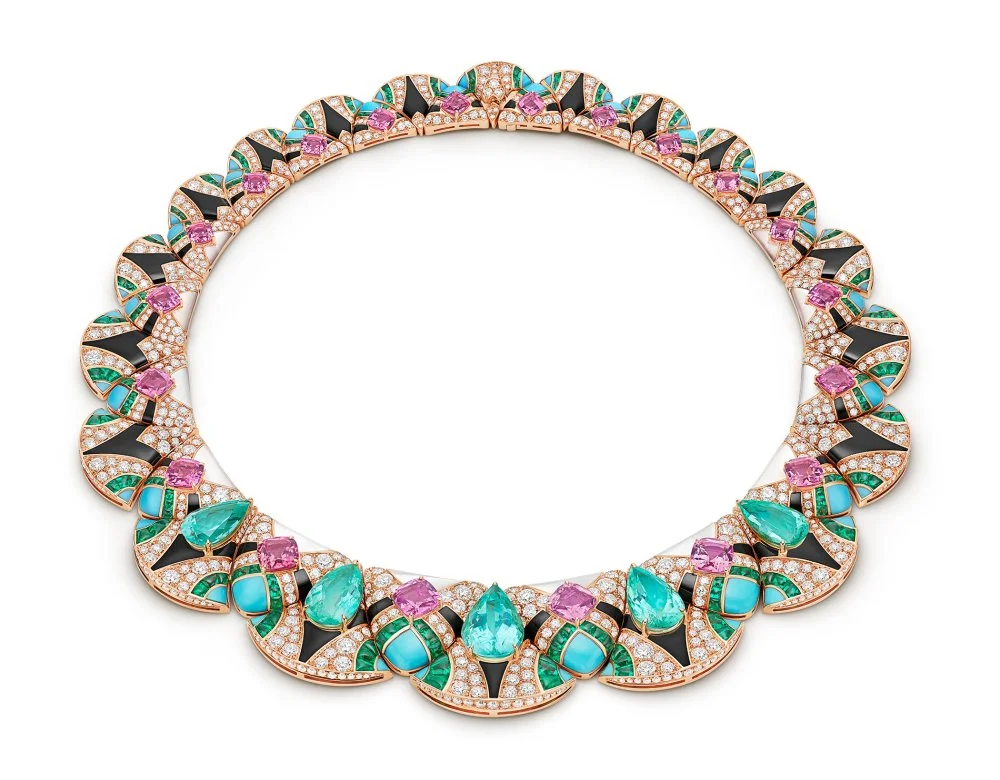
Necklace Mosaic of Time with Paraiba tourmalines
Everything changed with the appearance of the paraiba tourmaline in the late 1980s, which is quite recent by the standards of jewelry history. In the Brazilian state of Paraiba, a unique deposit of copper-containing tourmalines was discovered. These gemstones are of a green-blue color, reminiscent of the color of ocean water illuminated by the sun in a tranquil lagoon. The stone proved to be so beautiful and unusual that within a few years, its price overtook most gemstones. The demand was fueled by the fact that the Brazilian deposit was quite small, and it was clear that there would not be enough stones for all those who wanted them. And indeed, the Brazilian mines were soon exhausted. The scarcity was somewhat alleviated by the fact that tourmalines containing copper were found in Nigeria and Mozambique and were generally similar to those from Paraiba.
While experts say that the ‘true’ Brazilian paraiba is much richer and more interesting than the African stones, the problem is that these same experts generally do not know how to distinguish between the two varieties. The optical spectroscopy of both stones is almost the same, so the proof of the Brazilian origin of the stone can now only be its documents, which, of course, can be questionable. For this reason, the world’s jewelers have decided to ignore the question of origin and call any tourmaline that has the same chemical composition and quality as the Brazilian ones ‘paraiba’. The stone is indeed incredibly beautiful, and in honor of the paraiba, which has become one of the stars of the Bvlgari collection, the company has even released a fragrance called ‘Omnia Paraiba Bvlgari’.
Questions for a gemologist: Paraiba has such a delicate color—are there any peculiarities in the storage and care of the stone?
‘In discussing the color of the paraiba tourmaline, we must first say that in the modern market, the color of the paraiba tourmaline is 99 per cent the result of ennoblement,* [*Tooltip: Ennoblement is a process of enhancement or treatment performed on gemstones in order to achieve their vibrant hue.] and this is a common practice. Tourmalines containing copper are heated to moderate temperatures to obtain the desired greenish-blue and deep blue hues. The undoubted advantage of the paraiba tourmaline is the stability of the resulting color. It remains stable even under the influence of solar ultraviolet light, even as many stones fade under the influence of ultraviolet light in direct sunlight. The color stability does not depend on the deposit and yes, the color of Brazilian paraiba is visually indistinguishable from an African one. So when you buy a paraiba tourmaline, you can be sure that its color will not change over time.
‘Storage and use recommendations are standard for most gemstones and products. We store them in a closed case and avoid mechanical and shock impacts.’
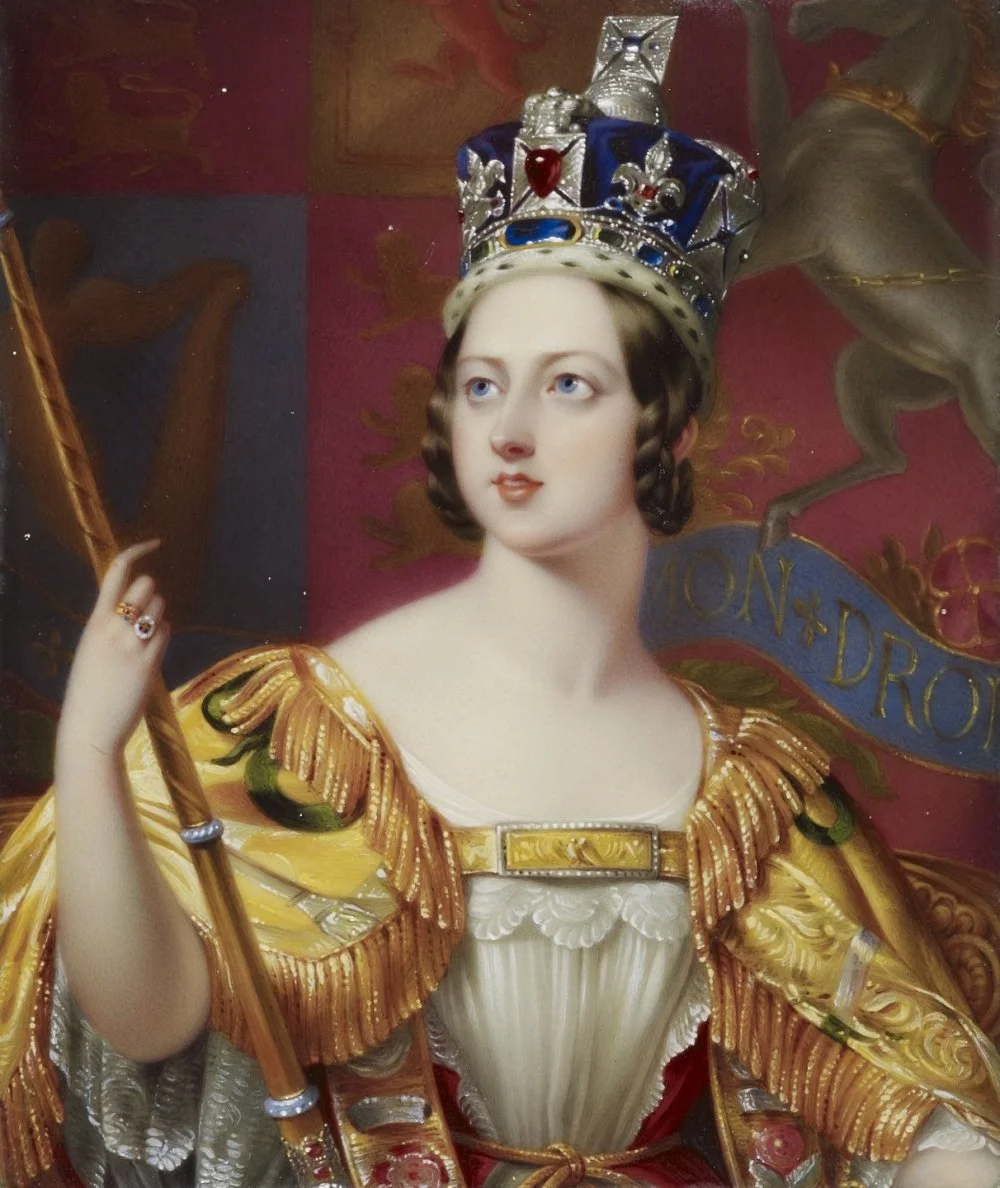
Henry Pierce Bone : Queen Victoria (1819-1901). 1843/Wikimedia Commons
Sapphire
Sapphire, a gemstone with a biography spanning many millennia, also has a rather complicated history. First, the ancient Jews, Greeks and Romans, who wrote a lot about sapphires as the finest gemstones, did not mean sapphires at all, but lapis lazuli. It was lapis lazuli that was the blue stone of kings, emperors, magicians, and priests that we find so often in ancient literature. It is easy to understand this fact when you read about how ‘sapphires’ were ground into powder to get a rich blue paint. This trick does not work with real sapphire, and it is lapis lazuli that gives the blue pigment. At the same time, the ancient Persians may have actually meant the real sapphire, a hard corundum of deep blue color that was mined in India at the time.

Necklace with sapphire. Bvlgari
It is usually cut to emphasize the luster and transparency of the sapphire. In eastern culture, it was customary to engrave wise sayings or magical signs on sapphires — here it was believed that this stone gives a person spiritual powers. The deep dark blue color of sapphire has been associated in many cultures with divine wisdom, knowledge, will and reason.
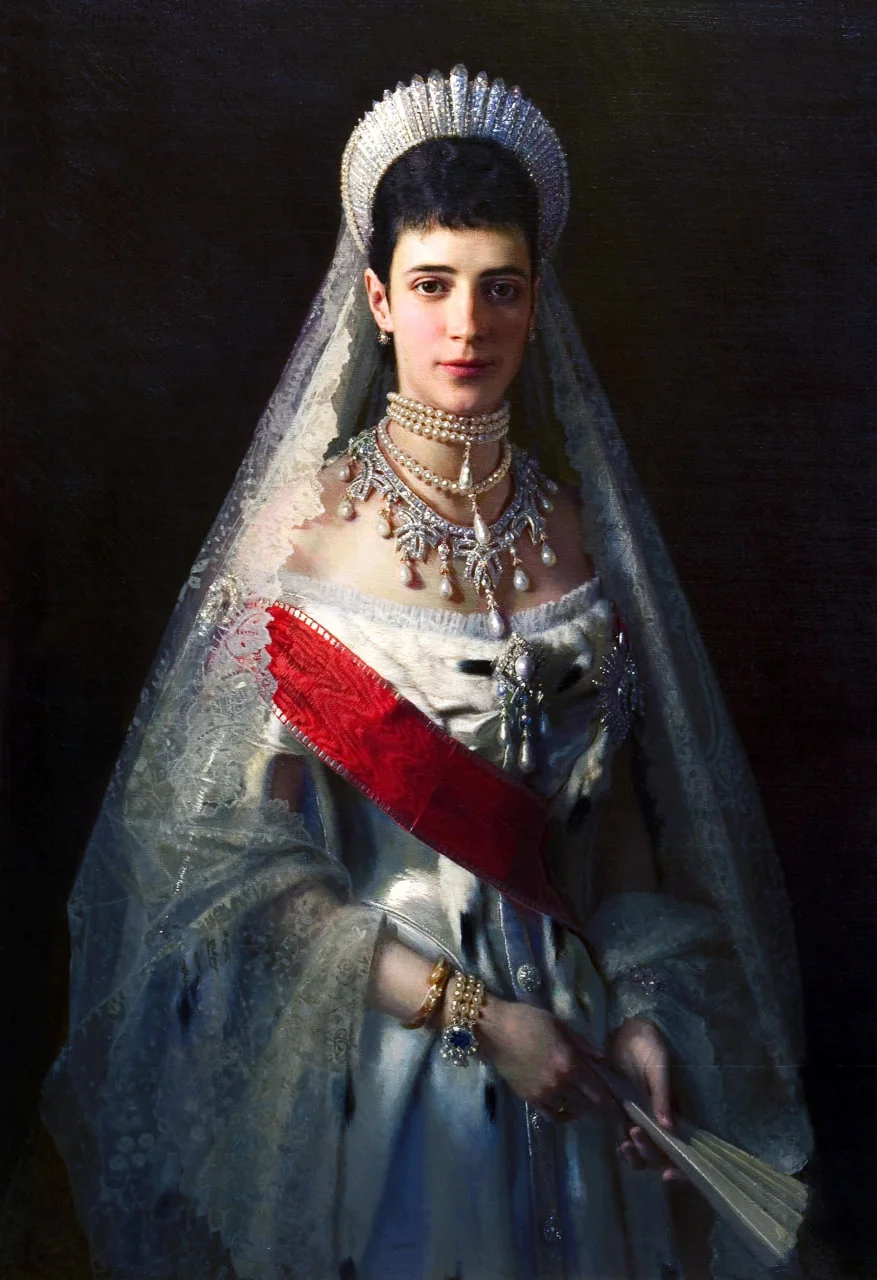
Maria Fyodorovna (1847-1928), 1880. Ivan Kramskoi (1837-1887) Formerly Princess Dagmar of Denmark, as the wife of Alexander III, Tsarina of Russia 1881-1894. Jewels Diamond Pearl Sapphire/Getty Images
But the development of mineralogy has made its own adjustments — today jewelers call any corundum sapphires except red ones (they are called rubies). There are yellow, green and even transparent sapphires. Which, of course, creates confusion in terms, because the adjective "sapphire" still means a bright dark blue color.
Questions for a gemologist: Which sapphires are the most valuable right now?
‘There is an interesting situation in the market right now. On the one hand, the most sought-after sapphires on the market are natural, unheated stones of a royal blue color, which is a spectrally pure blue color with high saturation and no additional gray or greenish tones. It is a classic color that shines to its best advantage in direct sunlight and has been prized for hundreds of years.

Albert Moore (1841-93) 'Sapphires' (1877) the title reflects the colour of the stones worn by the model/Getty Images
‘On the other hand, there is a growing interest in the padparadscha sapphire, an amazing stone that combines pink and orange in equal proportions. It is believed that the true padparadscha must come from Sri Lankan deposits, and the Sri Lankans compare its color to the lotus flower or the color of a Lankan sunset, which is such a romantic story! The stone is quite rare—the “real” padparadscha is rarer than the bluest royal blue. The Chinese and Middle Eastern markets are very interested in this stone, which in turn leads to its very high and constantly rising price in the world market. It is the Holy Grail of the sapphire world.’

Padparadscha sapphire/Geology.com
